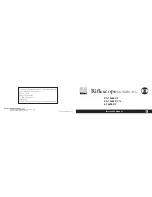
32
Description of each Menu
Menu ALIGN
This menu is the first menu to be displayed when the telescope is turned on. There are five sub menus under ALIGN.
Each of these is a different way to align the telescope. Here are the sub menus:
SKY
This is used for the initial Alt-Az two star alignment or updating your alignment during the
evening. If you are looking at a non-stellar object, you can center the object and update
your alignment in this mode.
NOTE: The Ultima 2000 uses two stars to align to the sky. If you align to two stars then
later align to a third, the telescope overrides the closer of the two original alignment stars.
This maximizes the distance between your alignment objects, even if you update your
alignment with many objects in one part of the sky. Alignment stars should be more than
20º apart.
EARTH
This is used to align to terrestrial objects that you have defined in the NEW Catalog
database (example given in Chpt. 8). Terrestrial objects don’t move as the night
progresses, so in this mode the positions of the objects are not updated with time. In Earth
mode, the telescope assumes the objects are not moving. An example is given in Chapter
8.
CHANGE
This mode allow the user to choose which alignment star he/she wishes to replace with a
third star. The Ultima 2000 uses two stars for its alignment to the sky. These stars remain
in the memory until you update it with a new alignment star. This setting allows you to
view the names of the stars the Ultima 2000 is aligned to. You may have reason to replace
one alignment star over another. This mode gives you the choice. An example is given in
Chapter 8.
EQ SOUTH
Use this setting in the Southern hemisphere with a polar aligned telescope. The polar
alignment accuracy is critical. The telescope implicitly uses the celestial pole for one of
the alignment objects. This way you only need one star to align the telescope. This setting
is useful for telescopes permanently mounted or being used remotely. A wedge is
necessary.
EQ NORTH
Use this setting in the Northern hemisphere with a polar aligned telescope. The polar
alignment accuracy is critical. The telescope implicitly uses the celestial pole for one of
the alignment stars. This way you only need one star to align the telescope. This setting is
useful for telescopes permanently mounted or being used remotely. . A wedge is
necessary.
When you first attempt to align the telescope to the sky, you are prompted to set the telescope to its downstops. This sets
the position of the encoders. There is a downstop for each axis, azimuth and altitude.
The azimuth downstop is referenced by two stickers on the drive base. Rotate the fork arms until the stickers are lined up.
The altitude downstop position is with the telescope tube pointed down. In this position, the pin on the front of the tube
presses flush against the pin on the fork arm. Gently move the tube down until it hits its stop. Don’t slam the two
downstop pins together; this could damage the pins.
When you first press ENTER at the ALIGN menu, the screen scrolls,
INITIALIZING.....












































